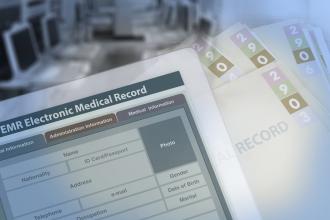M-health: Connecting patients to improve population and public health
Using wireless mobile communication technology to aid health services delivery (m-health) is a rapidly emerging concept around the world.
Using wireless mobile communication technology to aid health services delivery (m-health) is a rapidly emerging concept around the world.
Last year, the number of cell phone subscriptions surpassed 5 billion worldwide.[1] Statistics Canada recently reported that western provinces had the highest proportion of cell phone users in Canada, with over 80% of households in British Columbia having at least one cell phone. British Columbians are also increasingly replacing traditional landlines with their cell phones.[2]
Not to be confused with e-health (electronic management of health information and services) or telemedicine (the practice of medicine through telecommunication systems), m-health specifically harnesses the mobility and timeliness of wireless information and information communications technology (ICT) for health, including instant data transfer between health service providers and patients in increasingly limitless localities.[3]
From a cost and infrastructural perspective, cell phones are natural patient-level tools to consider, since they are already conveniently in the hands of a large majority of the Canadian public.
But can m-health actually improve health outcomes or make the delivery of health services more efficient? As m-health technologies and health services gather momentum, there has been a call for comparative effectiveness trials to provide scientific evidence. One such study, a multisite randomized controlled trial conducted in Kenya, assessed the ability of sending weekly cell phone text messages to HIV-infected patients to improve adherence to their antiretroviral medication.[4]
After the first year of treatment, patients receiving the text messages were 27% more likely to be highly adherent to their medications and 19% more likely to have fully suppressed viral levels than those who received standard care. Patients receiving the messages felt “like someone cares” and felt that they had access to personalized health advice when they needed it. Clinical trials in North America are showing promise that m-health can be used as a tool to help people quit smoking and to effectively support treatment for conditions such as diabetes and asthma.[5]
Our aim at the BC Centre for Disease Control is to assist in the control and prevention of communicable diseases among the people of BC and to defend and promote health among vulnerable populations. Within our Clinical Prevention Services we have two provincial clinics: the STI Clinic and the TB Control Clinic. Recently we conducted surveys among clinic attendees. Not surprisingly we found a high percentage of patients have access to cell phones (Figure). We have since initiated pilot studies to enable us to tailor interventions with the following goals:
• Improve access and support for vulnerable and traditionally hard-to-reach populations.
• Find innovative ways to improve the effectiveness and efficiency of communicable and chronic disease control.
• Reduce health system costs by remotely promoting health in the community and reducing reliance on emergency and hospital services.
Challenges will be encountered when implementing m-health strategies. First, although cell phone use is increasing, some remote or marginalized patients will not yet have adequate access to take advantage of new m-health applications.
Second, because the field is young and rapidly emerging, policymakers will need to sort through the myriad creative ideas and commercial innovations to find programs and services that will realistically achieve health care goals in the communities they intend to serve.
Third, the uptake of services and programs will depend on the value that key stakeholders (including patients) place on these services and how these services align with their needs, skills, and lifestyles.
Ultimately, communication between the public and health care providers using mobile technology is not intended to replace health services; instead it should enhance health service delivery. Technology that is fun, fast, easy to use, and makes people feel engaged has the best chance to make measurable improvements in population health.
Scientific evaluation, including cost-effectiveness analysis, is essential to ensure the best and most appropriate interventions are brought forward.[6] BC, with its clinical and public health institutions, academic leaders, solid technology private sector, and vision of equitable health services delivery, is well situated to move the province’s health systems forward to lead the way in m-health.
Acknowledgments
The authors would like to thank Dr Gina Ogilvie for her review of the manuscript.
This article is the opinion of the BCCDC and has not been peer reviewed by the BCMJ Editorial Board.
References
1. BBC. Over 5 billion mobile phone connections worldwide [news report]. 9 Jul 2010. Accessed 25 April 2011. www.bbc.co.uk/news/10569081.
2. Statistics Canada. Residential Telephone Service Survey. December 2010. Accessed 25 April 2011. www.statcan.gc.ca/daily-quotidien/110405/dq110405a-eng.htm.
3. Lester R, Karanja S. Mobile phones: Exceptional tools for HIV/AIDS, health, and crisis management. Lancet Infect Dis 2008;8:738-739.
4. Lester RT, Ritvo P, Mills EJ, et al. Effects of a mobile phone short message service on antiretroviral treatment adherence in Kenya (WelTel Kenya1): A randomised trial. Lancet 2010;376(9755):1838-1845.
5. Krishna S, Boren SA, Balas EA. Healthcare via cell phones: A systematic review. Telemed J E Health 2009;15:231-240.
6. The Economist. M-Powered: The convergence of mobile telephony and health care is under way. 11 November 2010. Accessed 25 April 2011. www.economist.com/node/17465455.

